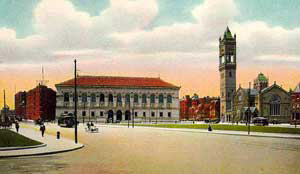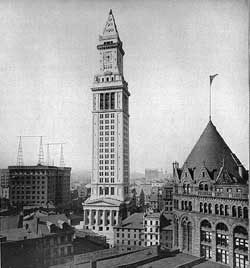The "Old" Suffolk County Court House and Other Boston Buildings

The Suffolk County Court House was never the largest building in Boston, either when it was completed in 1893 or when it was added to in 1910. Unfortunately for the building, it was constructed at a time of great creativity and energy in Boston's architectural landscape. The chosen location almost completely hid the edifice from the general population behind the other buildings of Pemberton Square.[1] Walter Muir Whitehill talks of the building being unceremoniously "plumped down" in Pemberton Square. Although the Old Suffolk County Court House was probably the most massive and densely built structure in the city, Boston already boasted larger, taller, and, in the opinions of many, far more elegant buildings.

If the original plan of architect George Clough had been completed with its large dome, the building would probably have rivaled the other grand buildings of the period like South Station, the Boston Public Library, the Ames Building on Court Street (the city's first skyscraper), Symphony Hall, and Trinity Church.
South Station when it was completed in 1899 was the largest and busiest railroad station in the country. The Boston Public Library, built almost at the same time as the Court House, from 1888 to 1894, was designed by Charles McKim of McKim, Mead & White, the nation's foremost architectural firm, and boasted a collection of artwork unsurpassed in the city. Among the international artists who contributed to the Library were Bela Pratt, John Singer Sargent, Daniel Chester French, Augustus St. Gaudens, Pierre Puvis de Chavannes and Edwin Austin Abbey. [2]
The addition of the "New" Suffolk County Court House in 1937-1939, sometimes called the "Tower," to the older Court House was also an instance where the building has never made an impression because of a number of factors. While some newspapers prophesied that the designs for the New Court House structure would literally overshadow the nearby State House, the final Art Deco design proved simple and unassuming.The location on what was left of old Pemberton Hill gives the illusion of the building being far taller than it is, but it was never the tallest. The Custom House Tower of 1915, an aesthetic Beaux Arts favorite, dominated the Boston skyline as the tallest building until that honor was claimed by the old John Hancock Building on Berkeley Street in 1949. [3]
Footnotes:
[1] WALTER MUIR WHITEHILL, BOSTON: A TOPOGRAPHICAL HISTORY 110 (3rd ed., 2001).
[2] GEORGE M. CUSHING, GREAT BUILDINGS OF BOSTON 67 (1982).
[3] Id, at 63.